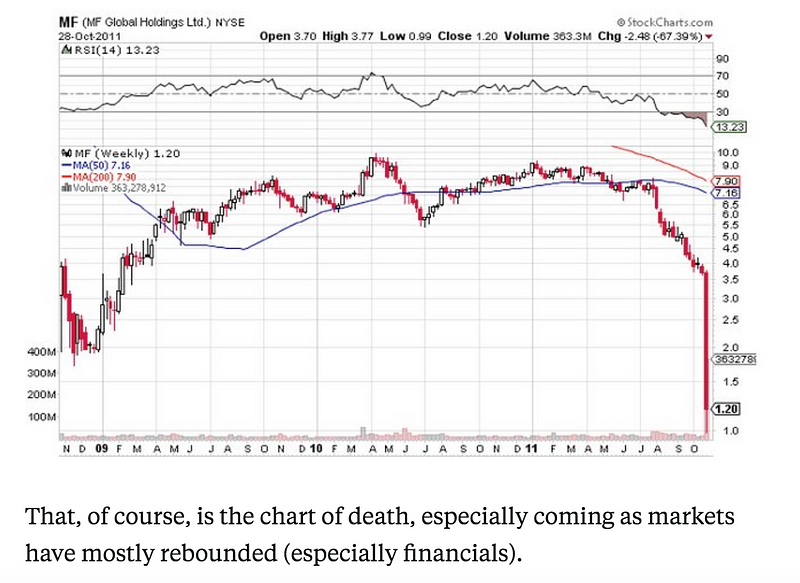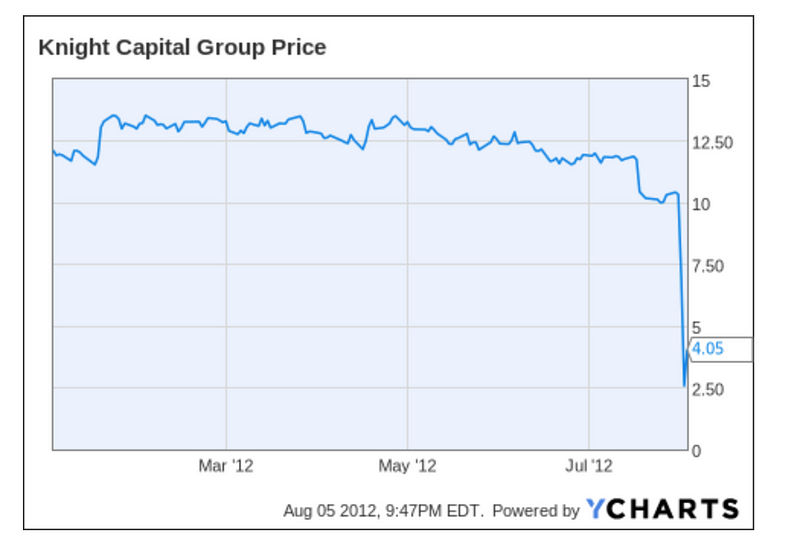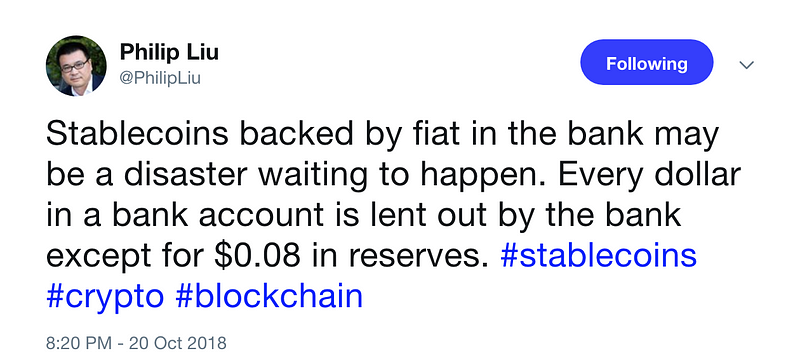What happened this week in the Crypto markets?
Crypto outperforms all other asset classes
The crypto market gained 3–4% last week, outperforming just about every other asset class. While global financial markets remain incredibly volatile, most other major markets ended the week largely unchanged.
- Most crypto indices +2–4%
- S&P Unched
- Nasdaq Unched
- VIX -8%
- Asian equities -2%
- Gold +1%
- Oil -4%
So… why did crypto outperform?
If you’re a news junkie, you may have noticed that almost every crypto data point last week was once again positive (the SEC working with ICOs, Fidelity entering the market, Bitgo getting a $43mm investment from Goldman Sachs and others, etc). Unfortunately, this past week’s price action was dominated by Tether (USDT). Beginning late Sunday night (10/14), the market was roiled by a potential “run on the bank”, sending the market into a brief period of turmoil which ultimately led to a flight to quality rally (Tether down, Bitcoin and everything else up). Crypto prices then gained further steam throughout the week once the Tether situation, and systematic risk, appeared to be back under control.
So rather than recap what has now been a very well-documented story for a solid week, we find it more interesting to discuss WHY most of the market narrative is missing the most important element of the Tether story. Confidence in financial systems is binary, and loss of confidence moves quickly.
[For those not up to speed on the USDT saga, here’s the 30-second recap: Tether (USDT) is meant to be a digital representation of $1.00 US Dollar, and can, therefore, be used to easily trade in/out of crypto positions without having to liquidate crypto back to traditional fiat currencies held in traditional banks. While it normally maintains a $1.00 peg, USDT traded as low as $0.85 last week. Bitfinex created USDT as an on-ramp/off-ramp currency for crypto and as such is its largest user].
Tether — history lessons from MF Global (MF) and Knight Capital Group (KCG)
To properly analyze Tether, we must first admit that it is a financial institution, of some sort. And there is plenty of precedences supporting what happens when financial institutions get stressed.
In the fall of 2011, MF Global (MF), a major global financial derivatives broker, filed for bankruptcy and wiped out $1.6 billion of equity (at the time, the 8th largest bankruptcy in US history). Less than 9 months later, another large brokerage firm, Knight Capital Group (KCG) came very close to suffering the same fate, but they were rescued at the last minute with a huge capital injection.
These two events, only 3 years removed from the 2008 financial collapse, demonstrated once again to market participants how fragile the global banking system really is. In short, because financial services companies either don’t own the assets they say they do or mark them at prices higher than they can actually sell them, the never-ending cycle of borrowing, lending, trading, and net interest margin is entirely based on the market’s confidence that they can continue this cycle uninterrupted. Once that confidence is lost, the gig is up… and quickly.
MF Global and Knight Capital Group represent the two extreme cases of what happens when the market loses confidence in a broker/exchange:
MF Global’s Demise
In 2011, MF Global incurred real losses from bad sovereign bond investments, tried to stem the bleeding by borrowing from customer accounts (illegally), and ultimately announced these losses to the market. In just 7 days, MF Global completely collapsed. The timeline of events is quite illustrative:
In June 2011, regulators began asking MF Global to increase its capital due to the company’s high exposure to European sovereign debt, and miraculously (fraudulently?) MF was able to raise money from investors in September.
On October 24, 2011, Moody’s downgraded MF Global’s credit rating to BBB, limiting their ability to raise future capital, and MF Global released earnings that indicated large losses (shares fell 40% that day).
Throughout that week, customers of MF Global began pulling money out of their brokerage accounts (similar to what we saw last week with Tether and Bitfinex), and rumors circulated that MF Global would be forced to sell assets or be bought — none of which came to fruition.
On October 31, 2011, just 7 days after confidence was initially lost, MF Global filed for bankruptcy, wiping out all equity value.
Just 2 weeks later, another mid-major investment bank (Jefferies) narrowly avoided the same fate as MF Global. The market lost confidence in JEF, shares tumbled 25%, and their largest shareholder (Leucadia) was forced to step in purchasing $12mm worth of JEF stock to calm the markets. Leucadia eventually bought the rest of Jefferies 6 months later. Without this equity injection, JEF likely would have met the same fate as MF Global.
MF Global (MF) — Stock price collapse in October 2011
Knight Capital’s White Knight
Just 9 months after MF Global filed for bankruptcy, another large brokerage firm, Knight Capital (KCG), also found itself in a precarious situation. They had just lost $400mm in a trade gone bad, and the market immediately began to discuss its solvency or lack thereof. Similar to MF Global, customers began pulling out, sending KCG into a death spiral. Furthermore, since this is the opaque financial services industry where nothing on a balance sheet means anything due to mismarked assets and repo agreements, there was no real way for Knight to adequately prove that it wasn’t insolvent. Fortunately for Knight (but less fortunate for its shareholders), KCG was rescued by a real White Knight, as a group of shareholders bailed KCG out with a $400mm equity injection. Granted, most of the equity value was lost for good, but at least Knight remained in business.
Knight Capital (KCG) — Stock price decline in August 2012
Source: YCharts
What does this have to do with Tether?
Both MF Global and Knight Capital (and even Jefferies) had about 7 days to bleed out or get stitched up, before a complete lack of confidence set in. We are now on day 8 of the Tether saga.
Unlike the persistent market narrative last week which continues to suggest that an “orderly unwind of Tether” is possible, history suggests this isn’t the case. There are likely only 2 possible scenarios:
- Confidence is restored, and USDT immediately trades back up to $1. This can happen in a few ways:
- Tether somehow proves that it has the assets in the bank that it says it does.
- A “White knight” publicly backstops all sales of USDT at some defined price (say, $0.95).
- Tether, Bitfinex and anyone else leveraged to the situation continues to buyback USDT at a discount and burn the tokens (taking a large loss to restore confidence and preserve the rest of their business lines).
- USDT goes down in flames, and there will be no more bids at any price, erasing roughly $2 bn of paper value. For those that think USDT collapse is good for the markets because people will have to sell USDT and buy BTC, ask yourself “who is going to buy the USDT?”.
In the meantime, we’ll watch USDT prices very closely, as this drama is not over. While it appears we may be on path 1, don’t rule out path 2.
The Irony of Centralized Decentralization
In an ecosystem designed to avoid centralization and single points of failure, the entire crypto market is now being held hostage by a single point of centralized failure (Bitfinex, Tether). However, we are fortunate that in 2018, there is now better diversification of risk among crypto exchanges than there was in 2014 during the Mt. Gox implosion. So while USDT is a mysterious, opaque stable coin that exchanges rely upon too heavily, its faulty existence or ultimate demise likely will not kill the industry. Regardless, in the supposedly “decentralized” global crypto asset ecosystem, we are spending way too much time discussing the solvency of a single centralized entity. That’s an ecosystem failure. Just remember:
Notable Movers and Shakers
Despite continued high correlations between crypto assets, portfolio returns are lately becoming more and more “catalyst dependent”. One look at September’s Index Prices, which varied from -6% to +4%, demonstrates just how important active management really is (token selection matters!). A few specific positive and negative outliers each week make the difference between a good week and a sub-par week.
In recent weeks, we’ve seen large positive moves from MKR, ZRX, BCH, XLM, and XRP, all driven by real partnerships and news. Last week was no different:
- Basic Attention Token (BAT), a well-known utility token designed to match incentives of content publishers, advertisers, and readers, jumped 51% last week. The move began after the release of the latest upgraded Brave browser which has seen some major improvements to speed, privacy and the user interface of the platform. The buying of BAT continued when rumors began circulating that BAT would be the next token added to Coinbase.
- Speaking of Coinbase, 0x (ZRX) gained another 24% last week and now sits 43% higher than 1 month ago. ZRX continues to benefit from its recent listing on Coinbase, as new investors are getting a chance to invest in the leading decentralized exchange protocol.
- Qtum (QTUM) gained 28% week-over-week after news broke that they are partnering with Amazon Web Services’ China division. The partnership sees the on-demand cloud computing giant working with a crypto project with a $325 million market cap, to develop blockchain-as-a-service solutions for enterprises and developers.
- Elsewhere, other top performing tokens include LINK (+14%), XLM (+17%), XRP (+13%) and POLY (+17%), all of which have been executing; this includes a real-world activity like partnerships and company/project growth. POLY specifically is now up almost 50% from September’s lows.
What We’re Reading this Week
By now you’ve heard, Fidelity launched and institutional custody and trading platform. Abigail Johnson, chairman, and chief executive of Fidelity Investments, said in a statement, “Our goal is to make digitally-native assets, such as bitcoin, more accessible to investors. We expect to continue investing and experimenting, over the long-term, with ways to make this emerging asset class easier for our clients to understand and use.”
This space isn’t for everyone.
Let’s just say custody is no longer an issue in this space… so Arca continues to focus on the real issues (lack of investable products for investors and a lack of education). BitGo, the maker of multi-signature cryptocurrency wallets for enterprises, has closed a $42.5 million Series B funding round in a sign that demand has at last arrived for institutional-grade services in the market.
Nice job here by the SEC, which announces FinHub, a portal to make it easier for crypto, blockchain, and other tech startups to communicate with the SEC.
Great job by a16z’s crypto division, who walks through how institutional investors think about investing in crypto assets.
Average daily volumes for bitcoin futures trading saw a significant jump in the third quarter compared to the last period, according to CME Group. While this news alone is neither good or bad for Bitcoin prices, it is positive for the whole industry that various derivative tools run by legit financial institutions are gaining in acceptance.
How’s your portfolio going to look? According to GMO ‘s well-respected models, you can expect a -5% real return per year over the next 7 years.
Arca in the Press & on the Streets
- Arca’s Portfolio Manager, Jeff Dorman, spoke on the “ Blockchain as an Asset Class ” panel at the CalALTS event in Los Angeles. He touched on many topics including risk management, crypto as a diversifier to an overall balanced portfolio, and why active management matters.
- Arca CEO, Rayne Steinberg, spoke on the Crypto 101 panel at Politicon 2018. The conversation was robust and addressed how blockchain could devolve political power back to the people as well as how it can be leveraged to ensure fair elections. Video to come later.
- Steinberg also spoke at Blockcon 2018 on the panel “To Invest or Not to Invest.” You can check out the video here.
And That’s Our Two Satoshis!
Thanks for reading everyone! Questions or comments, just let us know.
The Arca Portfolio Management Team
Jeff Dorman, CFA — Portfolio Manager
Katie Talati — Director of Research
Hassan Bassiri , CFA — Junior PM / Analyst
To learn more or talk to us about investing in digital assets and cryptocurrency
.jpg)


